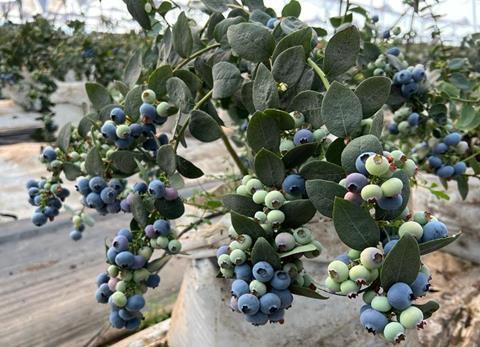Breeder says blueberry varieties with zero cold requirements are the key to maintaining production levels as temperatures rise

The high temperatures driven by El Niño are posing a major challenge for Peru’s blueberry industry this season. This circumstance, together with other factors such as water quality or excessive radiation, means that genetic innovation is a key alternative to face this new and complicated scenario.
In a season that has seen a significant drop in production volume, Daniel Bustamante, president of industry association Proarándanos noted that “new varieties, especially those that require zero hours of cold, have shown remarkable resistance to high temperatures”.
These varieties appear to be setting the standard when it comes to mitigating the problems caused by climatic change, reaffirming the idea that genetics is a key element in the evolution and sustainability of the sector.
Breeding specialist Planasa says it is essential that growers carefully select the varieties they plant, as climate change has become a normal and dominant component of agriculture. Choosing varieties that meet multiple requirements, such as yields, fruit quality and resistance, is crucial to compete efficiently in the global market.
International consultant and blueberry expert Carlos Castillo comments: “Growing conditions are constantly changing, mainly due to everything related to the climate. Along with the increase in CO2 in the atmosphere as a consequence of pollution, this is creating adverse conditions for blueberry production.
“The development of new varieties with adapted genetic characteristics is therefore essential to meet the production levels demanded by international markets, both in terms of quantity and quality”.
Planasa says its tropical blueberry genetics are the key to overcoming not only drought, radiation and stress, but also to guaranteeing long-term sustainability. The breeder highlights two varieties in particular.
“The first, Blue Madeira, is a highly productive and vigorous variety, with a surprising capacity to respond to abrupt changes in temperature,” the company says. “Its exquisite flavour and abundance of fruit when pruned make it an unbeatable choice for growers.
“The second, Blue Manila, is a super jumbo variety, renowned for its excellent flavour and earliness. It can be harvested between April and June, facilitating early pruning and allowing up to 1.5 seasons per year.”
According to Planasa, both varieties not only make the most of adversity to strengthen themselves, but also maintain high fertility, differentiation and culminate with a flavour that is irresistibly attractive to the consumer.
Both varieties are evergreen and require zero chilling hours, which allows them to adapt to tropical climates and gives them the ability to withstand unfavourable weather conditions and even enhance their characteristics, as they maintain their high fertility, differentiate very well and culminate with a very attractive flavour for the consumer, the breeder claims.
In addition, both varieties finish the season with very good material, as far as structure is concerned, for the following season.
Castillo continues: “Planasa’s varieties have performed very well over the last two years, when the increase in temperature and the ultraviolet light index have caused such great stress on old guard varieties such as Ventura and Biloxi that they have not produced well.
“New varieties such as Blue Madeira and Blue Manila have also managed to maintain their high production levels and exceptional quality in Peru and Mexico, achieving yields of 3.6kg per plant on average both in the current production cycle and in the second – at densities of 9,000 plants per hectare.
“In addition, they have had average calibres of 21mm, brix of 14º and an extraordinary bloom, so it is very clear that the vigour and resistance of the new varieties to extreme climate changes is one of their most outstanding characteristics”.



